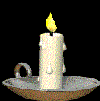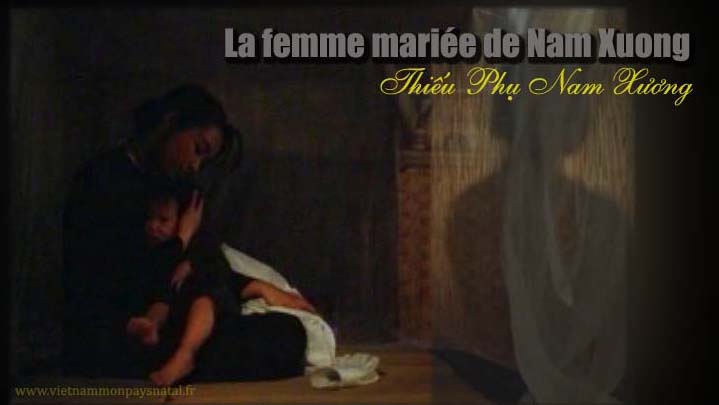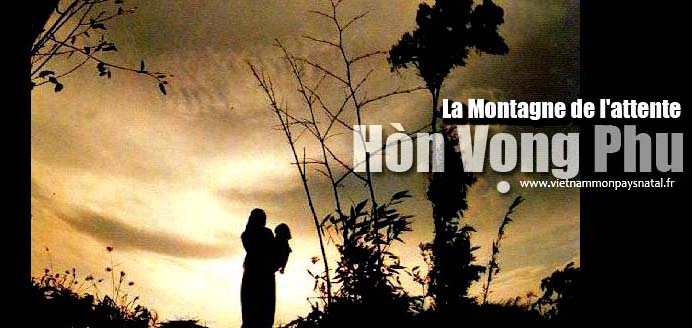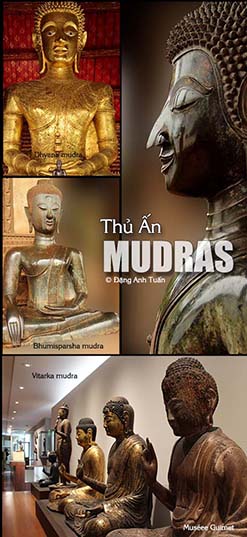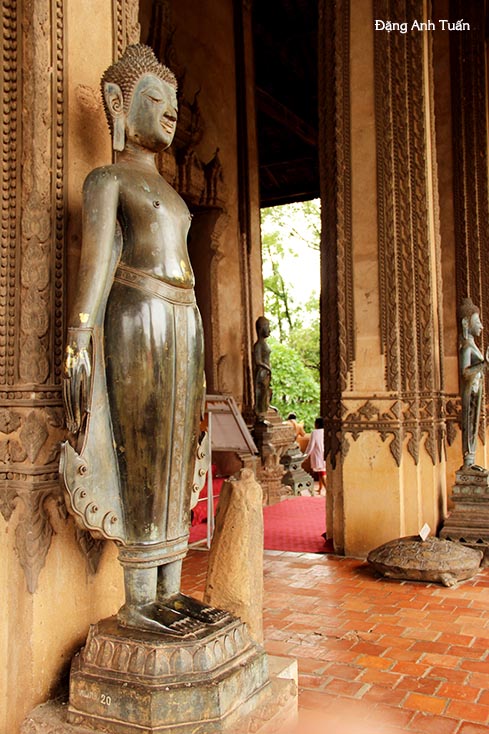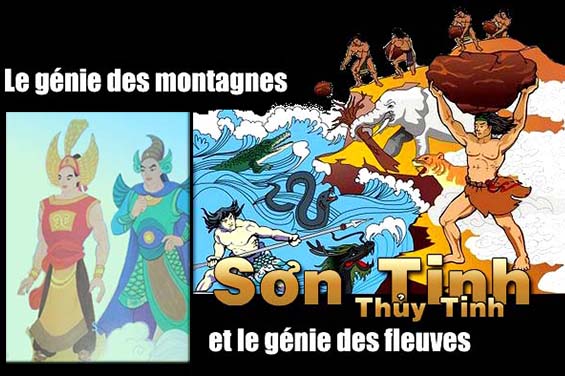
Version vietnamienne
Le gâteau de riz gluant (Bánh chưng bánh giày)
Le fils du premier roi du royaume Văn-Lang (Vietnam d’autrefois) régnait sous le nom de Hùng-Vương. Il avait trois épouses, chacune d’elles donnant naissance à un garçon. Le fils de la première, Long, se mariait à Kim, orgueilleuse et jalouse. Le fils de la seconde, Hồ, épousait Ngọc, méchante et acariâtre envers son mari. Le fils de la troisième décédée, Lang Liêu, vivait avec sa grand-mère maternelle et s’occupait des travaux agricoles. Il pratiquait la culture sur brûlis, cultivait les légumes ou allait pêcher aux heures de loisir. La grand-mère maria Lang Liêu à Xuân, une demoiselle sage et laborieuse du village. Le couple menait une vie modeste et heureuse.
Un jour, convoqués par le roi, ils durent vendre leurs deux buffles pour préparer le voyage. À la cour royale, ils virent leurs aînés et leurs épouses habillés élégamment et parés de bijoux. Lang Liêu et Xuân se sentirent confus. Tout le monde se moqua d’eux en leur reprochant de se présenter au roi sous une simple apparence.
Par contre, le roi se montra affectueux pour Lang Liêu, orphelin de mère. Accablé par la vieillesse et par le règne durant plus de 50 ans, le roi voulut céder le trône à celui qui pouvait préparer les mets les plus savoureux. Les épouses des deux aînés, confiantes de leur talent, rivalisèrent pour gagner le trône à leur mari. Seuls, Lang Liêu et Xuân furent très inquiets car ils étaient très pauvres.
Une nuit, dans un songe, Lang Liêu vit sa mère qui lui fit savoir qu’il serait l’élu du trône. Il lui suffit de faire deux gâteaux de riz gluant, l’un en forme de carré (bánh chưng) avec de la viande et de la graisse au milieu pour symboliser le cœur et l’autre en forme de rondeur (bánh giày) sans garniture. Les gâteaux carré et rond représentaient respectivement la terre et le ciel car on crut à cette époque que la terre était plate et carrée et le ciel étai rond. Lang Liêu se réveilla et raconta le songe à sa femme. Le couple décida de suivre les conseils de leur mère pour confectionner les gâteaux, puis les faire bouillir dans une marmite en argile cuite.
Au jour fixé, les deux brus Kim et Ngọc offrirent au roi des plats copieux et coûteux. Mais ce dernier ne trouva rien d’exceptionnel. Quant aux gâteaux offerts par Lang Liêu et Xuân, il fut ravi par leur délicatesse et par leur signification. (Il faut régner sur terre avec cœur et sagesse et se souvenir du grand mérite des parents).
Le roi combla Lang Liêu de louanges et le désigna comme son successeur. Pour sa générosité, Lang Liêu n’hésita à élever au titre de vicomtes ses frères. De ce jour, chaque année, lors de la fête du Têt, il prit l’habitude d’offrir sur l’autel de ses parents ces deux gâteaux de riz qu’il confectionna lui-même. Tous ses sujets commencèrent à l’imiter à cette occasion. C’est pourquoi le gâteau de riz gluant de Lang Liêu porta désormais le nom « Tiết Liệu » et devint ainsi l’une des friandises traditionnelles des Vietnamiens lors de la fête du Tết. On le sert souvent avec du porc au caramel. Ce gâteau est aussi la preuve intangible de la théorie du Yin et du Yang et de ses cinq éléments appartenant à Bai Yue (ou Cent Yue) dont les Proto-Vietnamiens font partie car on retrouve dans sa confection le cycle d’engendrement de ces 5 éléments.
Feu->Terre->Métal->Eau->Bois
À l’intérieur du gâteau, on trouve un morceau de viande de porc de couleur rouge (le Feu) entouré par une sorte de pâte faite avec des fèves de couleur jaune (la Terre). Le tout est enveloppé par le riz gluant de couleur blanche (le Métal) pour être cuit avec de l’eau bouillante (l’Eau) avant d’avoir la coloration verte sur sa surface grâce aux feuilles de bananier (le Bois). La forme de ces gâteaux était retrouvée à travers les disques bi et les Cong en jade et en ivoire dans les tombes des aristocrates de deux civilisations Lianzhu et Shijiahé avec l’idée de protéger les trépassés dans le monde des morts. Le disque bi était souvent associé au Ciel et avait la couleur verte tandis que le Cong dont la forme était tubulaire à l’extérieur et cylindrique à l’intérieur, était assimilé à la Terre et avait la couleur jaune. C’est pourquoi afin de commémorer les Anciens, à l’occasion de nouvel an lunaire, les gâteaux de riz ne peuvent pas être manquants sur l’autel des ancêtres.
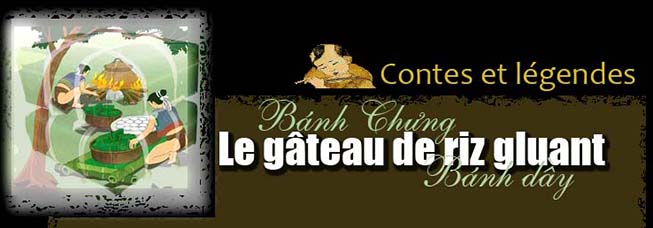
Version vietnamienne
Con trai của vị vua đầu tiên của vương quốc Văn-Lang (Việt Nam cổ đại) trị vì tên là Hùng-Vương. Ngài có ba người vợ, mỗi người đều sinh được một đứa con trai. Con trai trưởng Long lấy vợ Kim kiêu hãnh và ganh tị. Con trai thứ hai là Hồ lấy Ngọc, xấu tính và cay nghiệt với chồng. Con trai của người thứ ba qua đời tên là Lang Liêu, sống với bà ngoại và chăm lo công việc nông nghiệp. Anh làm nương rẫy thường ngày, trồng rau hoặc đánh cá lúc rảnh rỗi. Bà gả Lang Liêu cho Xuân, một cô thôn nữ ngoan ngoãn và chăm chỉ. Cặp đôi vợ chồng có một cuộc sống khiêm tốn và hạnh phúc.
Một ngày kia, được vua triệu tập, hai vợ chồng phải bán hai con trâu của mình để chuẩn bị cho chuyến đi. Ở triều đình, họ thấy vợ chồng của hai anh ăn mặc sang trọng và đeo đầy trang sức. Lang Liêu và Xuân cảm thấy bối rối. Mọi người đều cười nhạo họ, trách móc họ đến trình diện với vua cha với cách ăn mặc giản dị.
Ngược lại, vua cha biểu lộ sự trìu mến với Lang Liêu, mồ côi mẹ từ sớm. Nản lòng trước tuổi già và trị vì hơn 50 năm, nhà vua muốn nhường ngôi cho người con nào có thể chế biến được những món ăn ngon nhất. Vợ của hai anh cả tin tưởng ở tài năng của mình nên cố tranh giành nhau ngôi báu cho chồng mình. Chỉ có Lang Liêu và Xuân là rất lo lắng vì họ rất nghèo.
Một đêm, trong một giấc mơ, Lang Liêu thấy mẹ của mình về , báo cho anh biết rằng anh sẽ được ngôi vua. Chỉ cần phải làm là hai chiếc bánh gạo nếp, một chiếc có hình vuông (bánh chưng) với nhân thịt và mỡ ở giữa tượng trưng cho trái tim và chiếc còn lại hình tròn không nhân (bánh giày). Hai chiếc bánh hình tròn và hình vuông nầy tượng trưng cho trời và đất vì thời đó người ta tin rằng trái đất bằng phẳng là hình vuông và trời thì tròn. Lang Liêu tỉnh dậy và kể lại giấc mơ cho vợ. Hai vợ chồng quyết định nghe lời mẹ làm bánh rồi sau đó đem luộc bánh trong nồi đất nung.
Đến ngày quyết định, hai cô con dâu Kim và Ngọc dâng vua cha những món ăn cao sang đắt tiền. Nhưng vua cha không tìm thấy có chi đặc biệt cả. Đối với những chiếc bánh của Lang Liêu và Xuân, vua cha lại hoan hỉ vì vừa thấy ngon và có ý nghĩa của các bánh gạo nếp. (Cần phải trị vì với đạo lý và khôn ngoan và nhớ đến công đức sinh thành lớn lao của cha mẹ)
Nhà vua khen ngợi Lang Liêu và chỉ định làm người kế vị. Vì lòng hào hiệp của mình, Lang Liêu không ngần ngại phong anh em mình lên hàng tử tước. Kể từ ngày đó, cứ đến Tết hàng năm, vua Lang Liêu lại có thói quen cúng trên bàn thờ cha mẹ hai chiếc bánh chưng bánh dày do chính tay vua làm. Tất cả mội người dân bắt đầu bắt chước vua từ đấy . Đó là lý do tại sao bánh nếp của Lang Liêu ngày nay mang tên “Tiết Liệu” và trở thành một trong những món ăn truyền thống của người dân Việt trong ngày Tết. Nó thường được ăn chung với thịt lợn kho. Chiếc bánh chưng cũng là bằng chứng xác thực của thuyết Âm dương và ngũ hành thuộc về đại tộc Bách Việt trong đó có người Việt cổ vì chúng ta tìm thấy trong cách chế tạo của bánh có ngũ hành tương sinh:
Hỏa->Thổ->Kim->Thủy->Mộc
Bên trong bánh có một miếng thịt lợn màu đỏ (Hỏa) bao quanh bên ngoài là loại bột nhão làm bằng nhân đậu màu vàng (Thổ). Toàn bộ được gói bằng gạo nếp có màu trắng (Kim) trụng với nước sôi (Thủy) trước khi có màu xanh trên bề mặt nhờ có lá chuối (Mộc).Hình dáng Bánh Chưng bánh giày này được trông thấy trong các mộ qúi phái của hai nền văn hoá Lương Chữ và Thạch Gia Hà qua các đĩa bi và cong bằng ngọc bích và ngà trong bối cảnh nghi lễ và thường có nhiệm vụ bảo vệ người về thế giới bên kia. Bi thường được kết nối với trời và màu xanh, trong khi tông, với hình dạng hình ống vuông ở bên ngoài và hình tròn bên trong, được liên kết với đất và màu vàng.Bởi vậy để tưởng niệm người xưa, các bánh chưng bánh giày không thể thiếu trên bàn thờ tổ tiên nhân dịp Tết Nguyên Đán.

